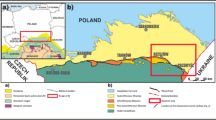Abstract
Seismic facies classification plays a critical role in characterizing & delineating the various features present in the reservoirs. It aims at determining the number of facies & their description for the available seismic data. During the past few decades, seismic attributes have been widely used for the task of seismic facies identification. It helps geologists to determine different lithological and stratigraphical changes in the reservoir. With the increase in the seismic data volume & attributes, it becomes difficult for the interpreters to examine each seismic line. One of the solutions given to this problem was to use some computer-assisted methods such as k-means, self-organizing map, generative topographic map and artificial neural network for analyzing the seismic data. Even though these computer-assisted methods performed well but due to the size of the 3-D seismic data the overall classification process becomes very protracted. In this paper, we introduce a parallel framework for unsupervised classification of the seismic facies. The method begins by calculating four different seismic attributes. Spark & Tensorflow based implementation of unsupervised facies classification algorithms are then used to identify the seismic facies based on the 4-D input attributes data. Further, the comparison of results (in terms of execution time & error) of Spark & Tensorflow based algorithms with already existing approach show that the proposed approach provides results much faster than previously existing MPI based approach.
Access this chapter
Tax calculation will be finalised at checkout
Purchases are for personal use only
Similar content being viewed by others
References
Anees, M.: Seismic attribute analysis for reservoir characterization. In: 10th Biennial International Conference and Exposition (2013)
Chopra, S., Marfurt, K.J.: Seismic Attributes for Prospect Identification and Reservoir Characterization. Society of Exploration Geophysicists and European Association of Geoscientists and Engineers, Tulsa (2007)
Coléou, T., Poupon, M., Azbel, K.: Unsupervised seismic facies classification: a review and comparison of techniques and implementation. Lead. Edge 22(10), 942–953 (2003)
Du, H., Cao, J., Xue, Y., Wang, X.: Seismic facies analysis based on self-organizing map and empirical mode decomposition. J. Appl. Geophys. 112, 52–61 (2015)
dGB Earth Science: Open Seismic Repository (2016)
Grana, D., Lang, X., Wu, W.: Statistical facies classification from multiple seismic attributes: comparison between Bayesian classification and expectation-maximization method and application in petrophysical inversion. Geophys. Prospect. 65(2), 544–562 (2017)
Han, J., Pei, J., Kamber, M.: Data Mining: Concepts and Techniques. Elsevier, New York (2011)
Karau, H., Konwinski, A., Wendell, P., Zaharia, M.: Learning Spark: Lightning-Fast Big Data Analysis. O’Reilly Media Inc., Sebastopol (2015)
Kearey, P., Brooks, M., Hill, I.: An Introduction to Geophysical Exploration. Wiley, Hoboken (2013)
Ketkar, N.: Introduction to TensorFlow. In: Ketkar, N. (ed.) Deep Learning with Python: A Hands-on Introduction, pp. 159–194. Apress, Berkeley (2017). https://doi.org/10.1007/978-1-4842-2766-4_11
Kodratoff, Y.: Introduction to Machine Learning. Morgan Kaufmann, Burlington (2014)
Kohonen, T.: The self-organizing map. Neurocomputing 21(1), 1–6 (1998)
Meng, X., Bradley, J., Yavuz, B., Sparks, E., Venkataraman, S., Liu, D., Freeman, J., Tsai, D., Amde, M., Owen, S., et al.: MLlib: machine learning in Apache Spark. J. Mach. Learn. Res. 17(1), 1235–1241 (2016)
Mojeddifar, S., Kamali, G., Ranjbar, H.: Porosity prediction from seismic inversion of a similarity attribute based on a pseudo-forward equation (PFE): a case study from the North Sea Basin, Netherlands. Petrol. Sci. 12(3), 428–442 (2015)
Morrison, D.F.: Multivariate Analysis, Overview. Wiley Online Library (1998)
Opendtect: OpendTect (2016). https://dgbes.com/index.php/software. Accessed 20 May 2017
Pelleg, D., Moore, A.W., et al.: X-means: extending k-means with efficient estimation of the number of clusters. In: ICML, vol. 1, pp. 727–734 (2000)
Qi, J., Lin, T., Zhao, T., Li, F., Marfurt, K.: Semisupervised multiattribute seismic facies analysis. Interpretation 4(1), SB91–SB106 (2016)
Roksandić, M.: Seismic facies analysis concepts. Geophys. Prospect. 26(2), 383–398 (1978)
Roy, A., Dowdell, B.L., Marfurt, K.J.: Characterizing a Mississippian tripolitic chert reservoir using 3D unsupervised and supervised multiattribute seismic facies analysis: an example from Osage County, Oklahoma. Interpretation 1(2), SB109–SB124 (2013)
Sabeti H, Javaherian A: Seismic facies analysis based on k-means clustering algorithm using 3D seismic attributes. In: Shiraz 2009–1st EAGE International Petroleum Conference and Exhibition (2009)
Tibshirani, R., Walther, G., Hastie, T.: Estimating the number of clusters in a data set via the gap statistic. J. R. Stat. Soc.: Ser. B (Stat. Methodol.) 63(2), 411–423 (2001)
Wen, R.: 3D modeling of stratigraphic heterogeneity in channelized reservoirs: methods and applications in seismic attribute facies classification. Recorder Off. Publ. Can. Soc. Geophysicists 29(3), 1–14 (2004)
Zhao, T., Jayaram, V., Roy, A., Marfurt, K.J.: A comparison of classification techniques for seismic facies recognition. Interpretation 3(4), SAE29–SAE58 (2015)
Zhao, T., Zhang, J., Li, F., Marfurt, K.J.: Characterizing a turbidite system in Canterbury Basin, New Zealand, using seismic attributes and distance-preserving self-organizing maps. Interpretation 4(1), SB79–SB89 (2016)
Author information
Authors and Affiliations
Corresponding author
Editor information
Editors and Affiliations
Rights and permissions
Copyright information
© 2018 Springer International Publishing AG, part of Springer Nature
About this paper
Cite this paper
Bedi, J., Toshniwal, D. (2018). Parallel Framework for Unsupervised Classification of Seismic Facies. In: Perner, P. (eds) Machine Learning and Data Mining in Pattern Recognition. MLDM 2018. Lecture Notes in Computer Science(), vol 10935. Springer, Cham. https://doi.org/10.1007/978-3-319-96133-0_34
Download citation
DOI: https://doi.org/10.1007/978-3-319-96133-0_34
Published:
Publisher Name: Springer, Cham
Print ISBN: 978-3-319-96132-3
Online ISBN: 978-3-319-96133-0
eBook Packages: Computer ScienceComputer Science (R0)




